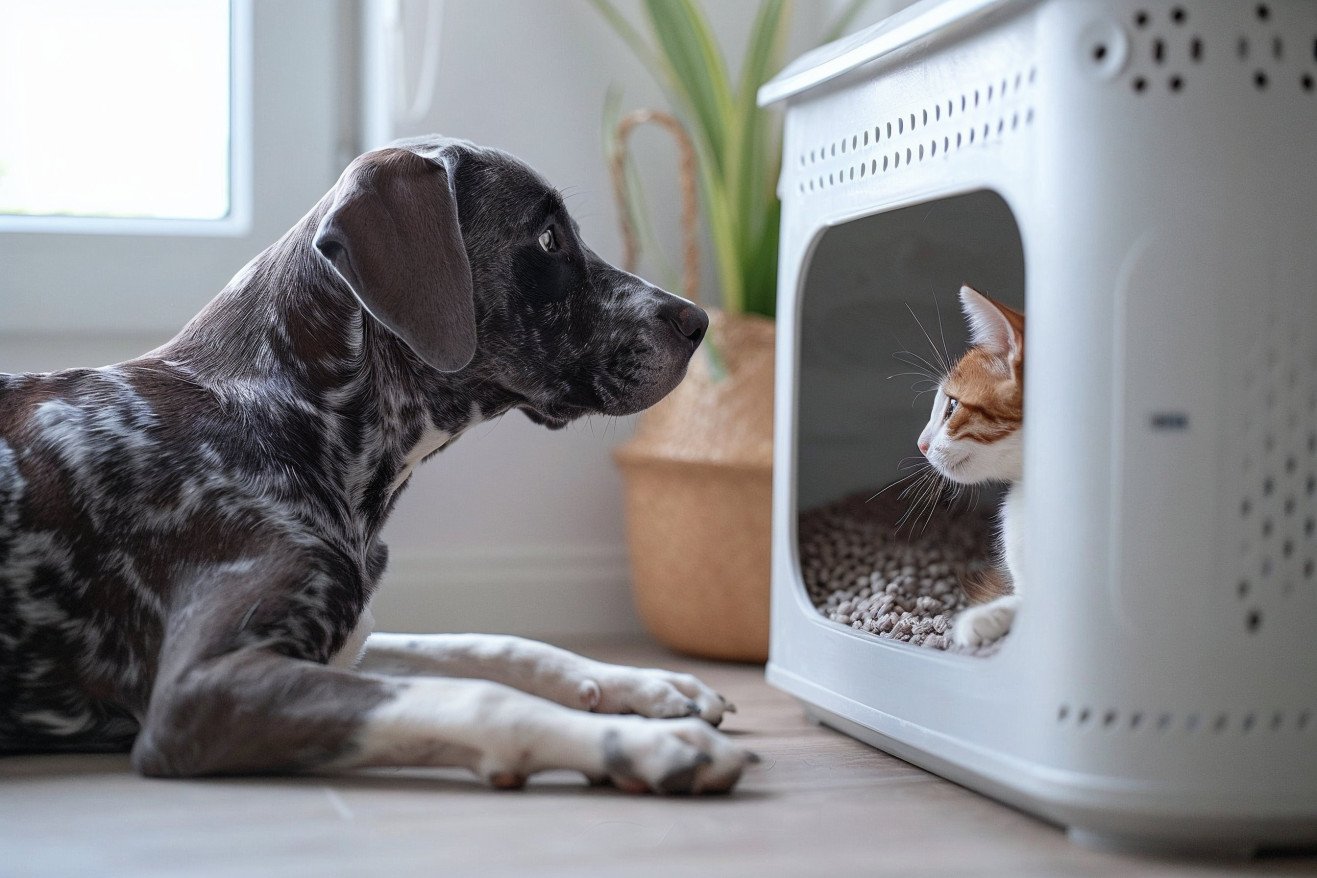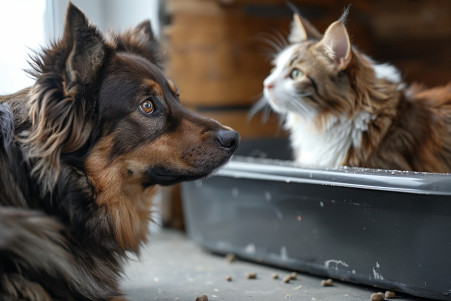How to Stop Dogs from Getting into the Cat’s Litter Box
18 February 2024 • Updated 16 February 2024

If you have a dog, you may have asked yourself how you can stop them from getting into the cat’s litter box. Some of the most effective ways to keep dogs out of the cat’s litter box include using physical barriers like baby gates or cat doors to keep dogs away from the litter box.
You can also choose a litter box with a top-entry or a cover, which makes it less attractive to dogs. Finally, you can discourage your dog’s interest in the litter box by training them and giving them their own toys.
In our investigation, we’ll look at animal behavior research, insights from veterinarians, and other evidence-based pet care studies to find out the best ways to keep dogs out of the litter box.
We’ll explore how different training methods, environmental changes, and the science of animal behavior all play a role in the solutions. By bringing this information together, we hope to offer a one-stop resource to help you create a happy, healthy, and clean environment for your cats and dogs.
What are the ways to prevent dogs from getting into the cat's litter box?
Solving the Mystery: Why Dogs Eat Cat Poop
If you have a dog and a cat, you may have experienced the frustration of your dog eating cat poop out of the litter box. This behavior, known as coprophagia, is more than just a minor annoyance—it also offers a glimpse into the mind of a dog.
According to VCA Animal Hospitals, dogs’ scavenging tendencies, which are left over from their ancestors’ need to hunt and forage for food, are one reason why dogs eat cat poop. Preventive Vet also notes that dogs may eat poop, especially that of other animals, out of curiosity or due to dietary deficiencies.
Knowing why dogs are more likely to eat cat poop can help you figure out how to stop them. Research into dog behavior has shown that there are training techniques that can help pet parents teach their dogs not to eat cat poop, and these studies have also shown that positive reinforcement is more effective than negative reinforcement, which is something that PetMD also points out.
Meanwhile, knowing that there are psychological and health risks associated with eating cat poop, including the risk of dogs being exposed to harmful bacteria and parasites, can help pet parents understand why it’s important to stop their dogs from eating cat poop.
Ultimately, learning why dogs eat cat poop can help pet parents better understand how to stop the behavior and ensure that their dogs and cats are safe. It can also help pet parents create an environment that discourages dogs from eating cat poop while also respecting their cats’ space.
Creating a Dog-Free Zone Around the Litter Box
If you want to keep the peace between your dogs and cats, creating a dog-free zone around the litter box is a smart move. You can do this by using baby gates or even installing cat doors.
This way, your cat can have a private space that’s free from the prying eyes of your dog. According to Bored Panda, these simple solutions can help keep your cat’s space safe and keep your dog from getting too curious.
Where you place these barriers is also important: putting the litter box in a high place or even a separate room will keep your dog from being able to get to it, says Lori Gardner from Litter-Robot.
When you combine these barriers with training, you can make sure your solutions are as effective as possible.
Not only will you be respecting your cat’s need for space, but you’ll also be minimizing the risk of health concerns like parasites that can be harmful if ingested, according to DVM Mohsin Iqbal.
Success stories in the real world have shown that when these changes are combined with things like regular cleaning and the use of automatic litter boxes, they can help reduce a dog’s interest in the litter box.
The Latest in Litter Box Technology: Keeping Dogs Away
The age-old problem of dogs invading a cat’s personal space has led to some major advancements in litter box technology.
One of the most popular solutions is the top-entry litter box, as well as the covered litter box.
A number of the latest models, including the Litter-Robot 4 and the Catit Jumbo Hooded Cat Litter Pan, have been designed to keep dogs out while still meeting the needs of cats in these specialized boxes. For example, the Frisco top-entry model offers a more affordable option, with high walls and a small opening that will keep most dogs out while still allowing cats to get in easily.
Of course, the effectiveness of these boxes will depend on a number of factors, including the size and agility of the dog, as well as the cat’s willingness to use the new box. In fact, one study found that it’s important to take the cat’s preferences into account, as some cats, especially older or less agile ones, may be less willing to use a top-entry box.
As a result, these dog-proof litter boxes come with a number of pros and cons. While they can go a long way toward keeping dogs out of the litter, they need to be placed carefully and may require a period of adjustment for cats.
In the end, the perfect dog-proof litter box will be one that meets the cat’s needs, ensuring that they feel comfortable using it and that it fits seamlessly into the pets’ shared environment.
Customizing Dog Training: Behavior Modification Techniques
Behavior modification is important when it comes to creating a peaceful pet environment, especially when it comes to keeping dogs out of the cat’s litter box.
All of these techniques are based on positive reinforcement, which means that the dog is rewarded for the behavior that you want to see and that the reward increases the likelihood that the behavior will be repeated.
The LIMA (Least Intrusive, Minimally Aversive) method, which is recommended by the International Association for Animal Behavior Consultants, prioritizes the use of the least intrusive and minimally aversive behavior modification, which means that it’s both humane and effective.
It’s important to note that all of these techniques require consistency and patience. Anthony De Marinis, a certified professional dog trainer and a certified separation anxiety trainer, says that it’s also important to make sure that you customize the plan to the dog and the family.
For example, a successful behavior modification plan might include operant conditioning, which means that the dog is given a reward (like a treat or praise) for not going in the litter box.
Some of the challenges that dog owners may face when it comes to behavior modification include medical issues that are mistaken for behavioral issues and deeply ingrained behaviors.
However, these can be overcome by using techniques that focus on learning to read a dog’s body language and recognizing patterns in their behavior. While behavior modification does require a commitment of time and energy, it can help you create a peaceful pet environment and a cleaner, safer home for everyone involved.
From a Cat’s Point of View: Stress and Well-being
Cats need their privacy when it comes to their litter box, and the presence of dogs can lead to stress that has a direct impact on their well-being.
A systematic review published in ScienceDirect found that social and environmental factors have a significant impact on the welfare of indoor cats, and it stressed the importance of cats having a safe, secure space. If a dog is able to get to a cat’s litter box and disrupt this space, it can lead to stress-induced behaviors that can negatively affect the cat’s welfare.
A study published in PMC also shows the importance of minimizing stress in cats, noting that environmental stressors, including interactions with dogs, can lead to negative physiological and behavioral responses in cats. This is supported by research on feline interstitial cystitis in another article published in PMC, which found that stress was a significant risk factor for the development of lower urinary tract signs, a common health problem in indoor cats.
Not only can ensuring that a cat has a safe and secure space to use its litter box help prevent potential stress, but it can also help improve the relationship between the pet and its owner, leading to better health outcomes for the cat and any dogs in the home. By recognizing and accommodating the feline need for a safe space, pet parents can help ensure that their multi-pet home is a happy one.
Final Thoughts on How to Get Dogs to Stop Eating Cat Poop
By looking at how to stop dogs from eating cat poop, we have covered a range of solutions. From physical barriers like baby gates to the creative environmental changes we’ve made, we’ve shown how important it is to protect the cat’s space.
Even the products we’ve found, like the litter box that was designed with the needs of both dogs and cats in mind, show that there is a solution to this common problem. Meanwhile, we’ve also shown how important it is to use positive reinforcement to change our dogs’ behavior.
This is all part of the process to ensure our home is clean and safe for our pets. It’s important to remember that we have to be patient and persistent when we’re using these solutions.
After all, our pets’ well-being is a reflection of the time and effort we put into them. However, with the right tools, we can make sure that dogs and cats can live together in a way that makes everyone happy and keeps our homes clean.
This is a good reminder of the ongoing work we put into making sure our home is a safe and loving place for all of our pets.


